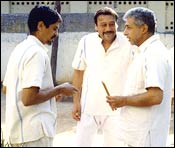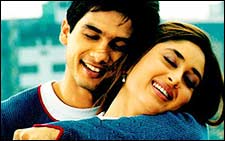In the early 1990s, Bryan Adams rocked the charts with the smashing hit Can't stop this thing we started. Trust me, the song can get you on the floor in no time and rid you from intense depression by its untouchable vivacity. But that's not what this article is about.
Besides being one hell of a mood elevator, this catchy ditty cheekily -- without intending to, of course -- sums up the how-to-end-the-film dilemma prevalent in Hindi cinema.
 Frequently, when you walk out of the theatre, you hear people discussing how good the first half was and how hopeless the second half turned out to be. It's not really the second half but the movie's tame ending that gets the audience's goat. And who can blame them? A film is paisa vasool only if it gives value for money till 'The End'.
Frequently, when you walk out of the theatre, you hear people discussing how good the first half was and how hopeless the second half turned out to be. It's not really the second half but the movie's tame ending that gets the audience's goat. And who can blame them? A film is paisa vasool only if it gives value for money till 'The End'.
For more than a decade, the trend involved the villain kidnapping the heroine or hero's mother/sister or both of them. The hero coming to their rescue and then, at last, khaki clad cops arriving on the scene to clean up the mess. In the end, the hero and heroine were shown taking the saat pheras and exchanging nervous giggles.
A slight variation would involve the villain kidnapping the heroine or hero's mother/sister or both of them. The hero along with his best friend -- ie, the second lead -- coming to their rescue. The latter dying while trying to save his bum chum. The police, again, arriving late on the scene. In the end, the hero and heroine are shown taking the saat pheras against the dead buddy's garlanded photograph. Somehow, they still exchange nervous giggles.
![]()
More on rediff.com!
![]()
![]()
![]()
![]()
Grand puja for Rajni's film![]()
Check out the Best of Movies!![]()
Vera Drake: All set for Oscar?![]()
![]()
![]()
The black and white era was perhaps the most original. You never really knew if there would be a happy ending. Even if it was a Dilip Kumar film, the viewer wasn't really 100 per cent sure what the tragedy king's fate might turn out to be. I knew he would die in Devdas but I did not anticipate another funeral in Musafir.
It wasn't just the unexpected death of the film's lead actor. Back then, even the hero and heroine's getting together remained a mystery till the final scene.
The
Before you can gather your wits, the film begins to make as much sense as a roller coaster ride. What? How? Why? Are just a few questions that stalk your mind as you discover that Shah is at the helm of all the murders, including the ones Shroff and Kukunoor are charged with.
Another example that comes to mind is Kya Yehi Pyaar Hai. This obscure love story featuring Aftab Shivdasani and Amisha Patel never made any sense to begin with. But its climax was priceless. Throughout the film the guy relentlessly, shamelessly, hopelessly chases the girl. And then suddenly, he changes his mind. Apparently, so does the girl. Now the girl gets into the whole relentless, shameless, hopeless chasing routine. No prizes for guessing what Narad Muni's take on this would be!
 There is nothing wrong in ending a film on an impractical note. Viewers love that kind of mushy crap. I am one of them. Okay, so it is impossible, unless you are Ethan Hunt, to conceive a black marketeer going steady with an aspiring actress (Rangeela) or a top-notch cop joining hands with the underworld only to secretly help the police force (Ab Tak Chhappan).
There is nothing wrong in ending a film on an impractical note. Viewers love that kind of mushy crap. I am one of them. Okay, so it is impossible, unless you are Ethan Hunt, to conceive a black marketeer going steady with an aspiring actress (Rangeela) or a top-notch cop joining hands with the underworld only to secretly help the police force (Ab Tak Chhappan).
But guess what? The audience loves the improbable. Though the traditionalist in them won't tolerate a much older Anil Kapoor falling in love with a much younger Sridevi in Lamhe. Dimple Kapadia has no other option but to die, because Farhan Akhtar's script refuses to let her hitch with the 'really mature in the head but rather young on the birth certificate' Akshaye Khanna in Dil Chahta Hai.
Majority, however, rules. And boy, do we love happy endings. Be it good triumphing over evil, the underdog winning a cycle race or a cricket match or unhappy triangles ending in happy quadrangles. We, the people (courtesy: Swades) just love to see a big smile on everyone's face, including ours.
Even if it means that the director will have to resort to convenient change of script. Remember Masoom? The desi interpretation of Erich Segal's emotional novel Man, Woman And Child had a different ending than the original. In the book and its Hollywood adaptation, the 'child' goes back where he came from. But in Masoom, the 'child' gets magnanimously accepted and receives heaps of love from the 'man,' 'woman' and their two daughters.
 Bollywood style redemption usually occurs in a film's last frame, more effectively when the wronged hero counts his last minutes. Ideally, he should be lying in his mother's lap (Deewar, Baazigar), sometimes father's too (as in Shakti), asking for forgiveness and at the same time, raking in a generous amount of sympathy from Mommy and the audience, irrespective of his previous black deeds.
Bollywood style redemption usually occurs in a film's last frame, more effectively when the wronged hero counts his last minutes. Ideally, he should be lying in his mother's lap (Deewar, Baazigar), sometimes father's too (as in Shakti), asking for forgiveness and at the same time, raking in a generous amount of sympathy from Mommy and the audience, irrespective of his previous black deeds.
The current scenario is worthy of note. Lately, filmmakers are open to experiment and try to dabble in unchartered territories. Daring to be different doesn't always pay. Take Fida. It tried to tread the unusual path by ending on a risky note. A heinous Kareena Kapoor conning the gummy-smiled hero is not palatable to our idealistic janta.
Though these kind of films didn't meet with a reassuring response, I hope filmmakers aren't deterred from thinking the unthinkable and moving away from the repulsive 'tried and tested' mentality. Films mirror life, which is so unpredictable and unrealistic in its own right. So why should the ending be any more unconventional?






 © 2025
© 2025